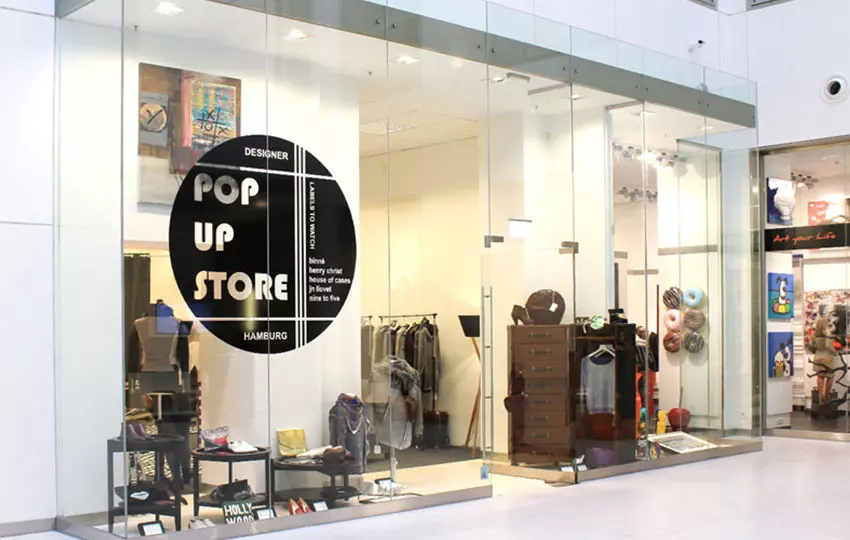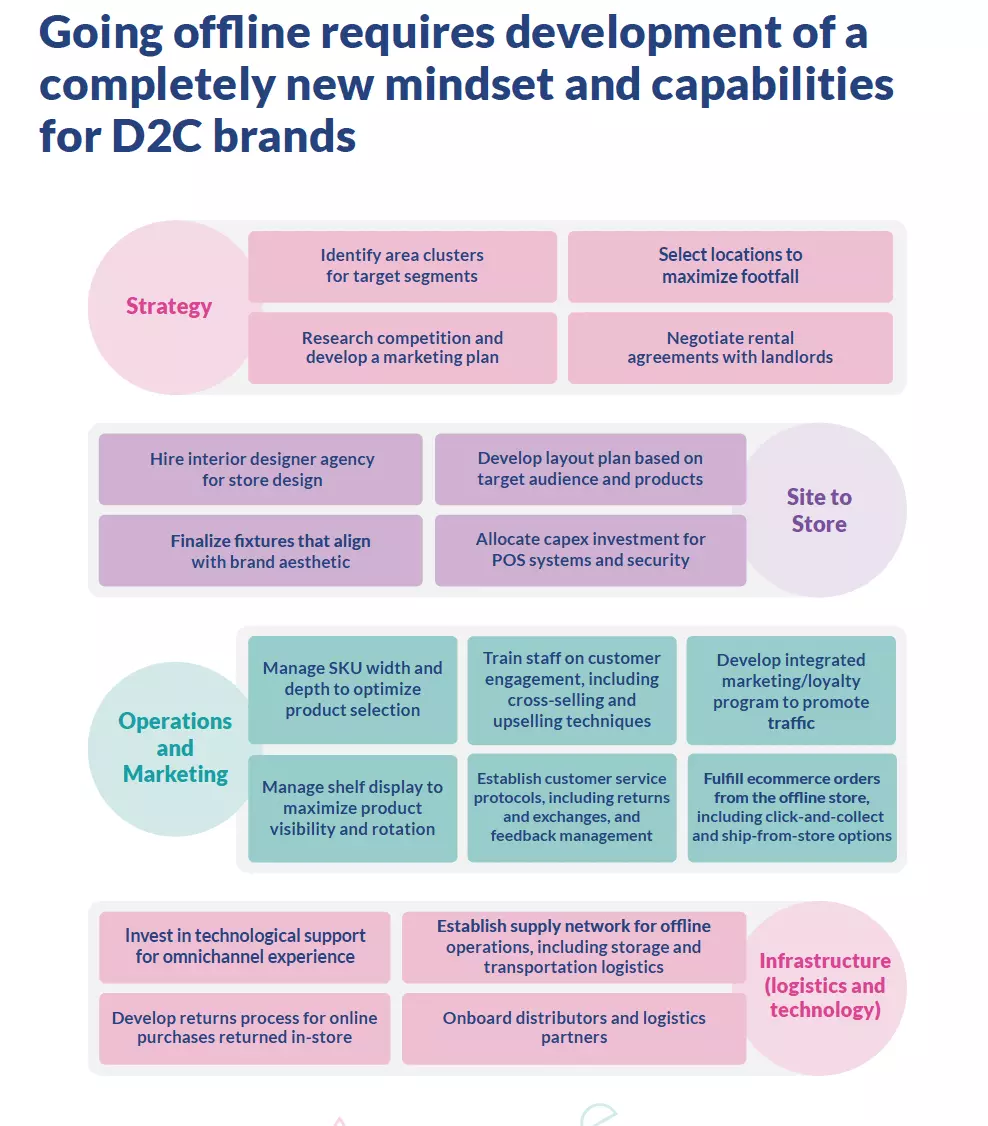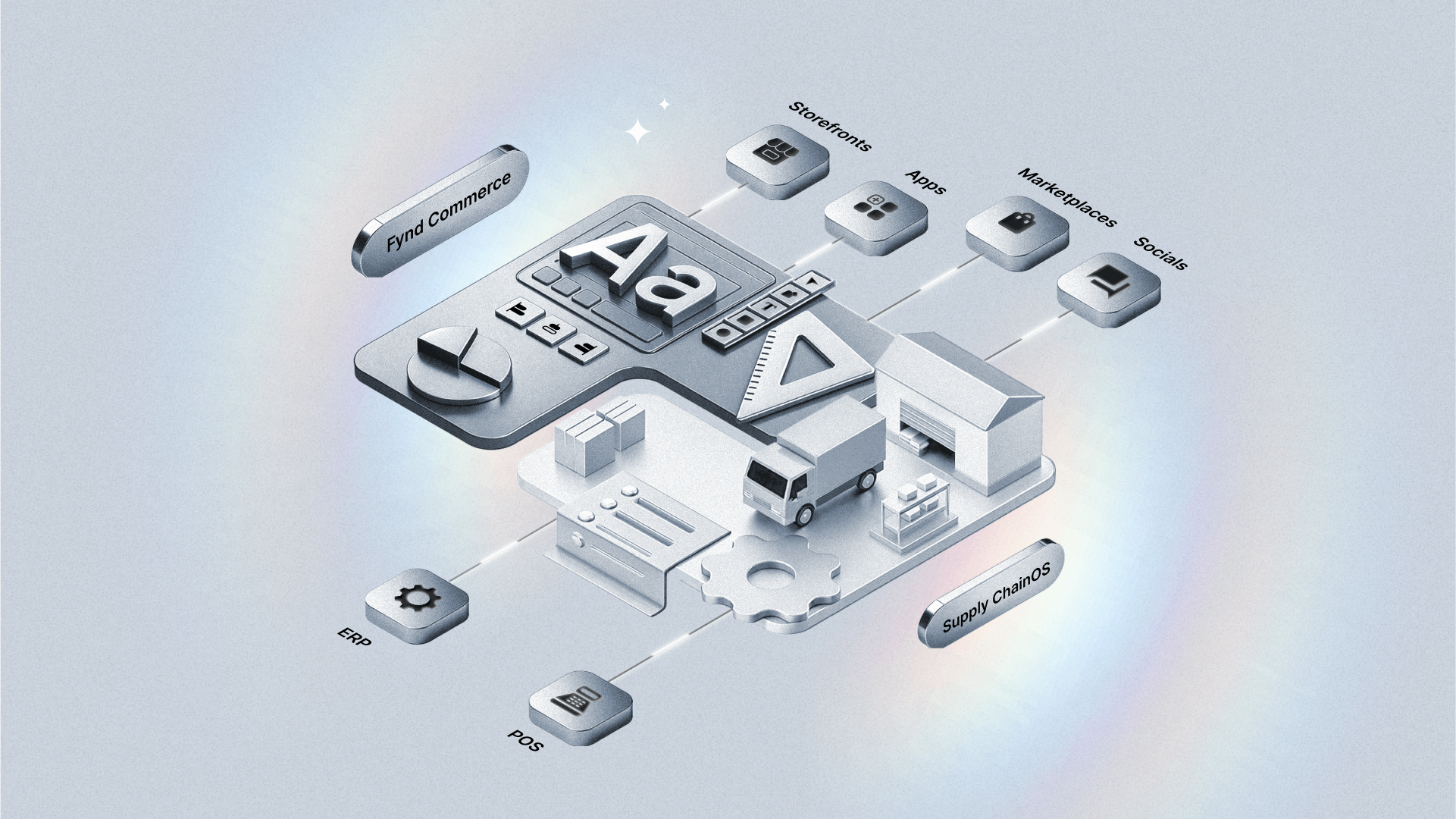Clicks to Bricks: Pioneering Strategies for D2C Brands for Offline Expansion

Direct-to-consumer (D2C) brands have experienced tremendous growth in the digital era, leveraging online platforms to reach consumers directly and disrupt traditional retail models. However, many D2C brands are now expanding offline to tap into new opportunities and connect with customers in a more tangible way.
In our previous blog—Click to Bricks: D2C Brands Embracing Offline Expansion, we talked about the online-to-offline shift for D2C brands, explored the reasons and benefits of this offline expansion, and discussed successful case studies for brands like The Souled Store, SUGAR, and Noise.
Having established the need and benefits, lets delve deep into effective strategies D2C brands must consider to successfully expand offline into physical stores in their omnichannel journey.
Integrating Online and Offline
To succeed with an omnichannel retail model, brands must integrate their online and offline operations. This includes:
- Offering the same product selection and pricing across channels. Customers expect consistency and become frustrated if they find lower prices or more options on one channel versus another.
- Providing a shared shopping cart and payment methods across channels. Customers should be able to shop online, then pay in-store or vice versa. They should also be able to return or exchange an item bought online at a physical store.
- Giving sales associates access to customers’ online shopping profiles and histories so they can provide personalized service. Associates should know customers’ preferences, past purchases, wish lists, and more.
- Leveraging physical stores as distribution centers for online orders. This makes delivery faster and more efficient, especially for same-day options. It also gives customers more flexibility in how they receive their items.
How to Choose a Physical Retail Strategy: Pop-Ups vs Showrooms vs Traditional Stores
As an online brand looking to establish a physical retail presence, you have several options to consider: pop-up shops, showrooms, or traditional stores. Each strategy offers unique benefits and drawbacks to evaluate based on your brand’s priorities and resources.
1. Pop-Up Shops

Pop-up shops are temporary retail spaces, typically lasting a few days to a few months. They allow brands to test physical retail with a low commitment. Pop-ups build buzz and brand awareness, especially on social media. However, their temporary nature means you may miss out on repeat customers and have limited time to learn from the experience. Pop-ups also require significant resources to plan and execute, even for a short time.
2. Showrooms
Like pop-ups, showrooms are temporary spaces, but they are designed primarily for customers to view and experience products, rather than make purchases. Showrooms require a smaller space and less inventory. They can be an easy way to introduce your brand to new markets and gain valuable customer feedback. However, without the ability for customers to buy on-site, you risk losing sales and momentum. Showrooms may be better suited as a supplement to e-commerce or other retail channels.
3. Traditional Stores
Permanent stores provide the most stability but also the biggest investment. They allow you to build long-term relationships with customers, optimize the retail experience over time, and gain important insights from in-person interactions. However, traditional stores come with significant overhead costs like rent, payroll, and inventory that can be risky, especially when first launching offline. For direct-to-consumer brands expanding into physical retail, the ideal strategy depends on your priorities, risk tolerance, and available resources. A thoughtful combination of multiple options may provide the benefits of each while mitigating the challenges. With any approach, be sure to thoroughly test and optimize to achieve the best results from your offline retail endeavors.
A. Opening brick-and-mortar stores:
D2C brands are setting up their own brick-and-mortar stores in prime locations. These stores serve as flagship outlets and act as brand experience centers, where customers can interact with the brand and its products.
B. Collaborating with established retailers:
Some D2C brands are partnering with established retailers to expand their offline presence. Through collaborations, these brands gain access to an existing customer base and benefit from the retailer's supply chain and distribution network.
C. Pop-up stores and experience centers:
Pop-up stores and experience centers allow D2C brands to create temporary physical spaces that generate buzz and attract customers. These limited-time stores offer unique experiences and serve as a platform for brand storytelling.
D. Leveraging franchise models:
D2C brands are exploring franchise models to scale their offline presence rapidly. By partnering with franchisees, they can establish a network of stores across different cities, leveraging local expertise and market knowledge.
Key Considerations When Expanding Into Offline Retail
Expanding from an online-only model into brick-and-mortar retail comes with several key considerations. As an ecommerce brand, you’ll need to adjust your strategy to reach customers in a new channel.
1. Location Selection
Choosing the right locations is crucial. Look for areas with lots of foot traffic from your target audience. You’ll want spots in trendy neighborhoods or near complementary stores. Scout locations in person to evaluate visibility, parking, and competition. Negotiate the best lease terms possible, as offline retail space is a major investment.
2. Product Assortment
Determine which of your products will resonate most with offline customers. You may need to adjust sizes or introduce new products specifically for retail. Provide a thoughtful curation of your collection to give the best brand experience in a physical space. Have enough product on hand to frequently refresh displays and replenish stock.
3. Staffing and Training
Invest in knowledgeable staff who can give customers a great in-store experience. Train employees on your brand values, products, and customer service standards. Educate them on how to assist online and offline customers alike. Staffing and training costs will significantly impact your budget, so plan accordingly.
4. Omnichannel Experience
Integrate your online and offline channels for a seamless customer experience. Allow customers to buy online and return or exchange in-store, and vice versa. Use the same loyalty programs and promotions across channels. Share customer data and insights between your ecommerce and retail teams to better personalize experiences. An omnichannel strategy is key to success.
5. Costs and Profitability
Expanding into physical retail will require upfront investment and ongoing costs for rent, build-outs, inventory, staffing, and more. Develop a comprehensive budget and monitor expenses closely. It can take time to become profitable, so go in with realistic expectations. With the right strategy and execution, an offline presence can significantly boost your brand and bottom line.The move into brick-and-mortar is a big step, but for digitally-native brands, it may be necessary to gain new customers and stay competitive. With careful planning and by following the key considerations outlined here, you can make your offline retail debut a success.
Tips for Indian Retailers to Adapt to the Changing Landscape
1. Embrace Omnichannel Strategies:
Indian retailers should adopt an omnichannel approach that seamlessly integrates their online and offline channels. This allows customers to have a consistent experience across touchpoints and enhances their shopping journey.
2. Invest in Technology and Analytics:
Investing in technology and analytics solutions enables retailers to capture and analyze customer data effectively. By leveraging insights from online and offline channels, retailers can make informed decisions, personalize offerings, and enhance customer satisfaction.
3. Foster Collaborations with D2C Brands:
Collaborating with D2C brands can be mutually beneficial. Retailers can leverage the popularity and unique offerings of these brands to attract customers, while D2C brands can tap into the existing customer base and infrastructure of the retailers.
4. Focus on Customer Engagement and Personalization:
In the competitive retail landscape, customer engagement and personalization are key differentiators. Indian retailers should invest in strategies that prioritize customer experience, such as personalized recommendations, loyalty programs, and interactive in-store experiences.
Strategy
- Identify area clusters for target segments
- Select locations to maximize footfall
- Research competition and develop a marketing plan
- Negotiate rental agreement with landlords
Site to Store
- Hire interiors designer agency for store design
- Develop layout plan based on target audience and products
- Finalize fictures that align with brand asthetics
- Allocate capex investment for POS systems and security
Operations and marketing
- Manage SKU width and depth to optimize product selection
- Train staff on customer enagement, including cross selling and up selling techniques
- Develop integrated marketing/loyality program to promote traffic
- Manage shelf display to maximize product visibility and rotation
- Establish customer service protocols including returns and exchanges and feedback management
- Fulfill ecommerce orders from teh offline stores including click and collect and ship from stores options
Infrastructure logistcis and tech
- Invest in technological support for omnichannel experience
- Establish supply network for offline operations, including storage and transportation logistics
- Develop returns process for online purchases returned in-store
- Onboard distributors and logistics partners

Strategies for D2C Brands for Offline Expansion
Direct-to-consumer (D2C) brands have experienced tremendous growth in the digital era, leveraging online platforms to reach consumers directly and disrupt traditional retail models. However, as the market evolves and consumer preferences change, many D2C brands are now considering offline expansion to tap into new opportunities and connect with customers in a more tangible way. In this blog post, we will explore effective strategies for D2C brands to successfully expand offline.
Strategy; Building a Strong Foundation: Key Strategies for Offline Expansion
%20-%20Copy.webp)
1. Identifying Area Clusters: Unleashing the Potential of Target Segments
Before expanding offline, it is crucial for D2C brands to identify the area clusters where their target segments are concentrated. Conduct thorough market research to understand the demographics, psychographics, and preferences of your target audience in different locations. This data will help you identify the most suitable regions or cities for your offline expansion.
2. Select Locations to Maximize Footfall
Location Selection: Where Footfall Meets Opportunity
Once you have identified the area clusters, carefully select the specific locations for your offline stores. Consider factors such as footfall, proximity to your target audience, accessibility, and the presence of complementary businesses. High-traffic areas, shopping malls, and popular neighborhoods are usually good choices to maximize visibility and attract potential customers.
3. Research Competition and Develop a Marketing Plan
Outshining the Competition: Crafting an Effective Marketing Plan
Understanding the competitive landscape is crucial for any offline expansion. Conduct a comprehensive analysis of the existing brick-and-mortar stores in your chosen locations. Identify their strengths, weaknesses, and unique selling propositions. Use this information to develop a marketing plan that highlights your brand's differentiators and communicates your value proposition effectively to customers.
4. Negotiate Rental Agreements with Landlords
Sealing the Deal: Mastering Rental Agreement Negotiations
Securing favorable rental agreements is a critical aspect of offline expansion. Engage in negotiations with landlords to ensure that you get the best possible terms and conditions for your stores. Consider factors such as rental costs, lease duration, flexibility for future expansion, and any additional services provided by the landlord. Negotiating a win-win agreement will set a solid foundation for your offline venture.
Site to Store
%20-%20Copy.webp)
From Concept to Reality: Transforming Spaces into Captivating Stores
1. Hire Interiors Design Agency for Store Design
Igniting the Senses: Enlisting an Interiors Design Agency
Creating a visually appealing and immersive in-store experience is essential for D2C brands. Collaborate with an interiors design agency that understands your brand identity and values. Work together to develop a store design that aligns with your brand aesthetics and creates a unique atmosphere that resonates with your target audience.
2. Develop Layout Plan Based on Target Audience and Products
The Art of Layout: Designing for Target Audience and Product Appeal
The layout of your store plays a crucial role in influencing customer behavior and facilitating smooth shopping experiences. Consider the preferences and behavior patterns of your target audience when designing the layout. Organize products in a logical and intuitive manner, making it easy for customers to navigate and find what they are looking for. Create dedicated spaces for showcasing new arrivals, bestsellers, and promotional items.
3. Finalize Fixtures that Align with Brand Aesthetics
Captivating Visuals: Fixtures that Embrace Brand Aesthetics
Fixtures and displays are essential elements in creating a cohesive and visually appealing store environment. Choose fixtures that reflect your brand's aesthetic and enhance the presentation of your products. From shelving units to lighting fixtures, ensure that each element aligns with your brand identity and creates a memorable shopping experience for customers.
4. Allocate Capex Investment for POS Systems and Security
Investing in Excellence: Capex Allocation for POS Systems and Security
Investing in robust point-of-sale (POS) systems and security measures is vital for smooth store operations and customer trust. Allocate capital expenditure (capex) to implement state-of-the-art POS systems that can handle transactions efficiently and integrate with your online inventory management. Additionally, prioritize security measures such as surveillance cameras, alarms, and anti-theft devices to safeguard your store and merchandise.
Operations and Marketing
.webp)
Seamless Experiences and Engaged Customers: Operational and Marketing Strategies.
1. Manage SKU Width and Depth to Optimize Product Selection
Curating Success: Optimizing SKU Width and Depth
Offline stores often have limited shelf space compared to their online counterparts. Therefore, it is essential to manage stock-keeping units (SKUs) strategically. Analyze sales data, customer preferences, and market trends to determine the optimal width and depth of your product selection. Focus on offering a curated range that showcases your brand's strengths while catering to the needs and desires of your target audience.
2. Train Staff on Customer Engagement
Elevating Interactions: Staff Training for Customer Engagement Mastery
Well-trained staff can significantly impact the success of your offline stores. Invest in comprehensive training programs that equip your employees with the necessary knowledge and skills to engage with customers effectively. Train them on customer service best practices, product knowledge, and sales techniques such as cross-selling and upselling. A knowledgeable and attentive staff can enhance the overall customer experience and drive sales.
3. Develop Integrated Marketing/Loyalty Programs
Loyalty Unleashed: Integrated Marketing and Loyalty Programs
To promote footfall and build customer loyalty, develop integrated marketing and loyalty programs that seamlessly connect your online and offline channels. Use various marketing channels such as email, social media, and in-store promotions to communicate exclusive offers, rewards, and events. Encourage customers to visit your offline stores through online campaigns and vice versa. By integrating your marketing efforts, you can create a cohesive brand experience for your customers.
4. Manage Shelf Display to Maximize Product Visibility and Rotation
Mesmerizing Displays: Maximizing Visibility and Rotation
Effective shelf display management can significantly impact sales and customer engagement. Analyze sales data and customer behavior to determine which products should be given priority placement on shelves. Regularly update and rotate products to create a sense of novelty and excitement. Experiment with visual merchandising techniques to draw customers' attention to specific products or collections. A well-curated and visually appealing shelf display can entice customers to explore and make purchases.
5. Establish Customer Service Protocols
Service Excellence: Protocols for Returns, Exchanges, and Feedback
Establishing clear customer service protocols is crucial for providing excellent post-purchase experiences. Develop protocols for returns and exchanges, ensuring they align with your brand's policies and local regulations. Train your staff to handle customer queries and complaints professionally and empathetically. Implement a feedback management system to gather customer insights and continuously improve your offline operations.
6. Fulfill E-commerce Orders from Offline Stores
Online-Offline Synergy: Fulfilling E-commerce Orders through Offline Stores
Utilize your offline stores as fulfillment centers to offer convenient services such as click-and-collect and ship-from-store options. This integration of online and offline channels enhances customer convenience and provides flexibility in how they access your products. Implement efficient inventory management systems to ensure accurate stock availability and seamless order fulfillment processes.
Infrastructure, Logistics, and Tech
.webp)
Connecting Channels, Empowering Growth: Building a Strong Infrastructure
1. Invest in Technological Support for Omnichannel Experience
Technological Marvels: Investing in Omnichannel Support
To enable a seamless omnichannel experience, invest in technological solutions that integrate your online and offline operations. Implement an enterprise resource planning (ERP) system that consolidates inventory, sales, and customer data across channels. This integration enables real-time visibility, efficient order management, and personalized customer experiences.
2. Establish Supply Network for Offline Operations
Efficient Supply Chain: The Backbone of Offline Operations
Expanding offline requires a robust supply network that supports your offline operations. Establish partnerships with distributors and logistics partners who can efficiently manage storage and transportation logistics. Ensure that your supply network is capable of handling the volume and frequency of inventory replenishment required for your offline stores.
3. Develop Returns Process for Online Purchases Returned In-store
Seamlessly United: Returns Process for In-store Returns
As customers increasingly choose to return online purchases in-store, establish a streamlined returns process to facilitate these transactions. Train your staff to handle returns efficiently and ensure that returned items are processed promptly. Implement inventory management systems that can accurately track returned items and update stock availability in real time.
4. Onboard Distributors and Logistics Partners
Partnerships for Success: Onboarding Distributors and Logistics Allies
Collaborate with distributors and logistics partners who can support your offline expansion. Identify partners with extensive experience in the retail industry and a strong distribution network. Work closely with them to ensure efficient and timely delivery of products to your offline stores. Regularly evaluate their performance and address any issues that may arise to maintain a smooth supply chain.
Conclusion
Offline expansion presents D2C brands with new opportunities to connect with customers, enhance brand experiences, and drive growth. By strategically identifying area clusters, developing compelling store designs, optimizing operations and marketing efforts, and investing in infrastructure, logistics
Frequently asked questions































%252520(1).webp)
